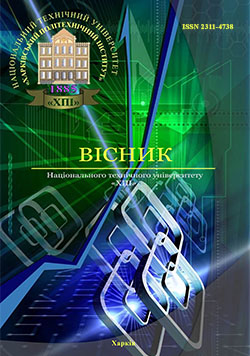STRUCTURAL MODEL OF THE INFORMATIVE SYSTEM OF DECISION MAKING AS TO RESOURCES MANAGEMENT IN THE PORTFOLIO OF PROJECTS OF THE AGRICULTURAL ENTERPRISE
DOI:
https://doi.org/10.20998/2413-3000.2016.1174.11Keywords:
structural model, resource management, portfolio of projects, agricultural productionAbstract
The peculiarities of management by projects at the agricultural production are analyzed. The available information software systems of the automated management by projects have a number of shortcomings, that does impossible its use in an agricultural production. The structural model of the information software system of decision making as to management by resources is worked out. The structural model consists of two subsystems of data storage and forming of well-organized calendar chart of portfolio projects, and model takes into account the features of projects of agricultural production. The structural model is the basis of effective implementation of projects portfolio. The proposed model provides of an avoidance of product losses of projects portfolio due to timely implementation of works. Information software systems by projects of the agricultural production are created on the basis of the worked out structural model allows to analyze risks and determine of the necessary standby of machinery and tractor units for the reliable realization of projects portfolio. Information software systems by projects of the agricultural production determine works in projects and corresponding machinery and tractor units that assume the product losses in projects through ill-timed implementation of technological operations.References
Tymochko V. O., & Padyuka R. I. (2013). Mozhlyvosti vykorystannya system avtomatyzatsiyi upravlinnya proektamy dlya umov sil's'kohospodars'koho vyrobnytstva [The possibility of using automation systems of project management for conditions of agricultural production]. Skhidno-Yevropeys'kyy zhurnal peredovykh tekhnolohiy - Eastern-European Journal of Eenterprise Technologies. 3/3(63). 26-28 [in Ukrainian].
Baranovskaya T., Loyko V. & Simoryan R. (2010). Modeli upravleniya ekonomikoy fermerskih hozyaystv (chast 1) [Management models of farms’ economy (Part 1)]. Nauchnyiy zhurnal KubGAU - Scientific journal KubGAU, 63(09). Retrieved from http://ej.kubagro.ru/2010/09/pdf/24.pdf [in Russian].
Loyko V. I., & Bogoslavskiy S. N. (2009). Upravlenie zernopererabatyivayuschim holdingom [Management of grain processing holding]. Nauchnyiy zhurnal KubGAU - Scientific journal KubGAU, 47(3). Retrieved from http://ej.kubagro.ru/2009/03/pdf/07.pdf. [in Russian].
Lutsenko E. V., & Loyko V. I. (2008). Reshenie zadach prognozirovaniya i podderzhki prinyatiya resheniy (upravleniya) dlya agropromyishlennogo holdinga na osnove ego dvuhurovnevoy semanticheskoy informatsionnoy modeli [The solution of problems of forecasting and decision support for the agricultural holding, based on its two-level semantic information model]. Nauchnyiy zhurnal KubGAU - Scientific journal KubGAU, 42(8). Retrieved from http://ej.kubagro.ru/2008/08/pdf/02.pdf [in Russian].
Lutsenko E. V., LoykoV. I., & Makarevich O. A. (2008). Sistemno-kognitivnyiy podhod k postroeniyu mnogourovnevoy semanticheskoy informatsionnoy modeli upravleniya agropromyishlennyim holdingom [System-cognitive approach to enginering of multi-level semantic information model of agro-industrial holding management]. Nauchnyiy zhurnal KubGAU - Scientific journal KubGAU, 41(7). Retrieved from http://ej.kubagro.ru/2008/07/pdf/11.pdf [in Russian].
Kolodyazhnyiy V. V., & Kuev A. I. (2005). Optimizatsiya ratsionalnogo ispolzovaniya resursov v fermerskom hozyaystve [Optimization of efficient use of resources at the farm]. Vestnik Adyigeyskogo gos. un-ta - Bulletin of Adygeya State University. 1. Retrieved from vestnik.adygnet.ru/files/2005.1/21/kolodyajniy2005_1.pdf [in Russian].
Tymochko V., & Padyuka R. (2014). Prediction of losses in agricultural production. ECONTECHMOD. Аn international quarterly journal. Vol. 3., 4, 55-58
Tymochko V.O., & Padyuka R.I. (2013). Identyfikatsiya parametriv vyrobnycho-tekhnichnykh resursiv portfelya proektiv sil's'kohospodars'koho pidpryyemstva [Identification of parameters of production and technical resources of the agricultural enterprise portfolio]. Visnyk L'vivs'koho NAU: Ahroinzhenerni doslidzhennya - Bulletin of the Lviv National Agrarian University: Agricultural and engineering researches, 17, 22-29 [in Ukrainian].
Tymochko V.O., & Padjuka R.І. (2014). Identifikacija tehnicheskih resursov v proekte proizvodstva sel'skohozjajstvennoj produkcii s ispol'zovaniem nejronnyh setej [Identification of technical resources in the project of agricultural production with the use of neural networks]. Motoryzacja i energetyka rolnictwa. Motrol-2014. Vol 14D. 25-30 [in Russian].
A Guide to the project management body of knowledge (PMBOK guide 5th editon). (2013). USA: PMI Standards Committee, 589 [in Russian].
Downloads
Published
Issue
Section
License
Copyright (c) 2016 Василь Олегович ТИМОЧКО, Роман Іванович ПАДЮКА, Іван Миколайович ГОРОДЕЦЬКИЙ

This work is licensed under a Creative Commons Attribution-NonCommercial-ShareAlike 4.0 International License.
Our journal abides by the Creative Commons copyright rights and permissions for open access journals.
Authors who publish with this journal agree to the following terms:
Authors hold the copyright without restrictions and grant the journal right of first publication with the work simultaneously licensed under a Creative Commons Attribution-NonCommercial-ShareAlike 4.0 International License (CC BY-NC-SA 4.0) that allows others to share the work with an acknowledgement of the work's authorship and initial publication in this journal.
Authors are able to enter into separate, additional contractual arrangements for the non-commercial and non-exclusive distribution of the journal's published version of the work (e.g., post it to an institutional repository or publish it in a book), with an acknowledgement of its initial publication in this journal.
Authors are permitted and encouraged to post their published work online (e.g., in institutional repositories or on their website) as it can lead to productive exchanges, as well as earlier and greater citation of published work.

